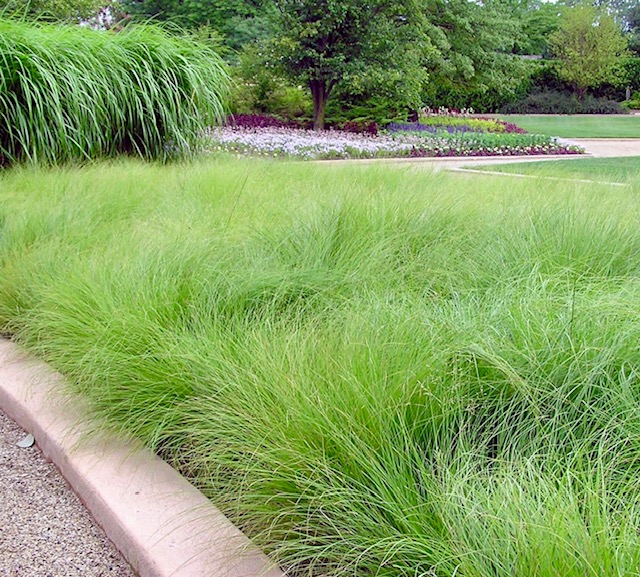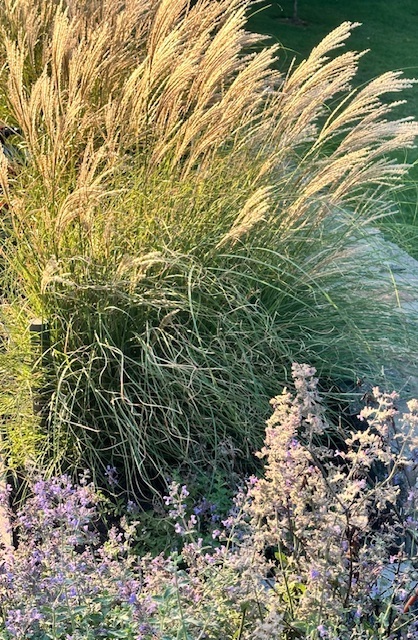Prairie Dropseed and the New American Garden Style
Gone are the days when dotted lines of petunias and rows of roses constituted a “garden”. While petunias and roses remain lovely as ever, the trend is toward a more naturalistic planting style. This “new/old” style incorporates ornamental grasses such as Prairie Dropseed and Fescue among other perennials, favors native flowering plants over others, and considers the soil and terrain when choosing plants to add.
History of this “New” Style
Why is this considered a new/old style? Well, although the use of ornamental grasses may seem new to some of us North American gardeners, it is a practice that has long been used in Europe.
German, Dutch, British, and other European gardeners have known the benefits of putting ornamental grasses and wildflowers to use in garden displays. And since the early 1980s or earlier, this style has been used in prominent public gardens in North America. Nevertheless, this New American Garden style, though named in this manner, has not quite permeated the garden beds that grace our stateside homes… at least not yet.
Benefits of Grasses in the Garden
What do ornamental grasses add to a garden?
- Grasses make the look of the garden less fussy, as if seeds have blown in on the wind to mature into gorgeous plants.
- Ornamental grasses grow well, without the need for soil amendments.
- Grasses can handle drought once established.
- They help prevent erosion, preserving the beauty of the land.

The notion of “seeds blowing in on the wind” may conjure up appealing imagery, or it might be a bit scary for gardeners who (rightly) worry about invasive plants. The ornamental grasses called Prairie Dropseed (yes, drop-seed) may make those among us who have faced a plant invasion worry. But Prairie Dropseed is actually a moderate grower and a moderate/minimal spreader. The same goes for Blue Fescue and Pink Muhly Grass—neither is interested in invading. Pampas grass, Fountain grass, and other grasses can indeed spread overzealously, but this is not the case for all ornamental grasses. The key is committing to just a bit of research so that you can find the grasses that best meet your needs.
How to Use Ornamental Grasses
Here are three ways you can make the most of ornamental grasses:
- Use them as border plants. Prairie Dropseed is perfect for a front border.
- Use ornamental grasses that develop into flowing, fountain-like mounds to create hedgerows, replacing boxwoods and more expected (stiffer) plants. Check out Miscanthus for this: Silvergrass, shown here.

- Try the more European approach/New American Garden approach by placing the ornamental grasses (Prairie Dropseed, Muhly, Fescue) here and there amid rocks, wildflowers, and not-so-native annuals.
Benefits of Adding Prairie Dropseed and Other Grasses to the Garden
Ornamental grasses such as Prairie Dropseed and the ethereal looking Pink Muhly grass are not only erosion-preventers but are also water-wise options for planting. When one thinks of a lawn and the water needed to keep it green, it might seem as though grasses would use up more water than other plants would need. But it is the opposite. Prairie Dropseed, strong and blue Fescue, bold yet graceful Pampas Grass… once established, these and other grasses use little water and can withstand periods of quite-severe drought.
A Note About Names
It is worth noting that there are lots of plants we call “grasses” that aren’t true grasses. Black Mondo Grass is not a grass but, instead, a member of the lily family. Fiber Optic Grass (perennial in the warmer states) is actually a sedge. You get the idea. And this might not matter to you one bit. Plants such as these have the appeal of grasses, contributing the same look to your garden beds, and many will perform as true grasses do. Just be “in the know”, doing a bit of pre-purchase research. There’s nothing better than a well-informed gardener.

Dropping a Hint
It seems right to drop a hint about Prairie Dropseed and other ornamental grasses: They are almost vital additions in today’s best gardens. Don’t be embarrassed if you have a couple of fussy areas around your yard. Maybe you did line up your petunias this year, or maybe you’re a big fan of symmetry. It’s okay. But do try a naturalistic planting style—one that incorporates ornamental grasses—in at least one of your garden beds. It’s likely that “one” bed will quickly become “all” when you see what these plants do to the look and performance of your gardens.
Comments
{{ errors.first("comment") }}